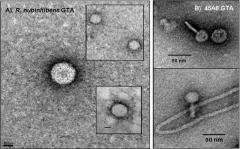October 4, 2010 report
Horizontal gene transfer in microbes much more frequent than previoulsy thought

(PhysOrg.com) -- A new study suggests that genes are transferred from one micro-organism to another up to a hundred million times more frequently than previously thought.
Virus-like particles called gene transfer agents (GTAs) are produced by alpha-proteobacteria and pass from one microbe to another, taking random pieces of genetic material up to 1,000 bases long with them. The high frequency with which this has been found to occur may provide a mechanism by which bacteria in the oceans acquire novel traits, and may play an important role in evolutionary processes.
One of the researchers, marine microbiologist John Paul, of the University of South Florida College of Marine Science in St Petersburg, said scientists had known “there’s a lot of gene shuffling going on in bacteria,” but until now no one had found a plausible mechanism for this horizontal gene transfer (as opposed to transfer of genes down the generations).
The existence of GTAs has been known since their discovery in 1974, but until now they were considered merely curiosities or laboratory anomalies. In the laboratory bacteria only produce GTAs in their “stationary phase”, which occurs when they are under stress through crowding, waste buildup and so on. The extent to which they play a part in nature outside of the laboratory was previously unkown, but they have been found in most members of the alpha-proteobacteria.
The team led by Paul first genetically engineered GTAs in two species of alpha-proteobacteria to contain a set of genes that conferred antibiotic resistance. They stressed the bacteria to initiate the stationary phase, and then filtered out and purified the GTAs.
They then sealed the GTAs in bags of seawater drawn from a variety of coastal environments in Florida and the Gulf of Mexico. The water samples were teeming with alpha-proteobacteria and other microbes. The bags were then floated in the ocean to simulate natural conditions. After incubation in antibiotics overnight, the various kinds of bacteria surviving in the samples were examined and genetically sequenced. The researchers found up to 47% percent of the naturally occurring bacteria had incorporated the GTAs and their genetic contents into their own genomes.
Lauren McDaniel, one of the co-authors of the paper said they were “absolutely amazed to see exact matches for the genes we put into the donor strain in different genera…” There are other means of horizontal gene transfer, such as cell to cell contact, by plasmids (mobile genetic elements) or by bacterial viruses, but these were unlikely to produce the results found.
The paper, published in the journal Science may help explain how bacteria can rapidly adapt to change, and quickly become resistant to antibiotics. Genes spread horizontally to other bacteria can lead to an increase in the frequency of those genes if they are beneficial and lead to better chances of survival.
More information: High Frequency of Horizontal Gene Transfer in the Oceans, Lauren D. McDaniel et al. Science 1 October 2010: Vol. 330. no. 6000, p. 5. DOI:10.1126/science.1192243
© 2010 PhysOrg.com

















